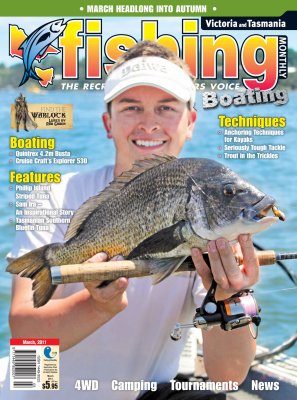Phillip Island Striped Tuna by Jarrod Day
 Back in the early 1970s, author Lance Wedlick wrote of commercial fishers catching large quantities of striped tuna along the coastline of Phillip Island.
Back in the early 1970s, author Lance Wedlick wrote of commercial fishers catching large quantities of striped tuna along the coastline of Phillip Island.
Back in the day, huge schools of stripies passed Cape Woolamai on their path around the bottom of Wilsons Promontory and were caught for commercial fish markets.
I had heard a rumour in 2008 that some striped tuna had been caught out from Barwon Heads but as there was no photographic evidence to prove such a catch, I was hesitant to believe it.
It was January of the 2009 season when I began to receive many reports of striped tuna being caught by anglers off Barwon Heads and by mid-January vast schools of these high speed pelagics had spread from Barwon Heads right to Kilcunda.
What I find most interesting about having striped tuna a viable catch off Phillip Island is some anglers are still quick to turn their nose up and say 'they're only stripies'.
While in other states they become a pest taking lures destined for other highly prized pelagics, I do think in Victoria or at least Melbourne, they deserve some credit as a marvellous sportsfish.
Many anglers make their annual trip to Bermagui in search of yellowfin or to Portland in search of bluefin, but for sheer exhilaration on light line, striped tuna are just as much fun.
What's best about having tuna so close to Melbourne's CBD is they are accessible to most trailer boats and can be a lot of fun on ultra-light tackle.
STRIPED TUNA SEASON
While you can't accurately put a time on when to go in search for them, past history from the 1970s shows January to March is the prime time. While we have only experienced a decent tuna season once in the last 30 years, it pays to troll small lures and keep an eye out for any surface activity during these months while chasing mako, thresher or just to bottom bounce for flathead offshore.
EYES IN THE SKY
Finding tuna in Bass Strait isn't easy, but providing you keep to a few simple rules you may just find success.
The striped tuna of Bass Strait are somewhat elusive and finding them can prove challenging. You may end up doing a few trips without success. Keeping an eye on the water's surface is the most effective way to locate the schools. Like any tuna fishing, they are usually located by finding large flocks of terns dive-bombing bait from above, while the tuna round up the bait schools from below the surface.
Once a school is found, they are often working on a school of bait and approaching the feeding mass can prove challenging as the sound of any boat approaching will make them disappear and reappear a few minutes later either in the same spot or a hundred or so metres away.
MOVING TARGETS
When approaching a school put a waypoint on your GPS. This will give you a reference point to go back to should they disappear. If you don't notice them reappear after a few minutes move away 100m or so and cut the engine. This technique often draws the school back to the surface and providing you have marked the spot you first encountered them, you will find them again nearby.